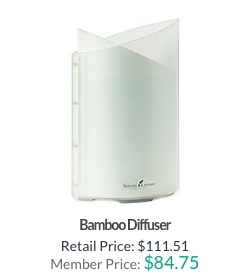DIFFUSE! 4 Types and Kinds
- 14
- Dec
 (Article adapted with thanks from AbundantHealth4u.com)
(Article adapted with thanks from AbundantHealth4u.com)
Diffuser types must be explained. I am often asked which diffuser is the best. Unfortunately, with so many different types available, it depends on what you like in a diffuser.
There are four different categories available on the market today– nebulizing, ultrasonic or humidifying, evaporative, and heat diffusers. Each differs in the way that it puts essential oils into the air, and each has different benefits.
Nebulizing Diffuser Types
A nebulizer works basically the same way a perfume atomizer works. A jet of air blowing across a small tube creates a vacuum that pulls a liquid at the bottom of the tube to the top of the tube. The airflow blowing across the surface of the oil at the top of the tube blows the oil away in a fine spray or mist. With a constant air supply source, this type of diffusion can quickly put a large amount of oil into the air.
Because this type of diffusion works to put the whole oil into the air in the form of tiny droplets, it is often considered the best type of diffusion for the therapeutic use of essential oils.
Since nebulizing diffusers work so powerfully to quickly saturate the air with essential oils, they generally run at a higher sound level, and they tend to use oil at a higher rate than any other type of diffuser. We generally recommend using a timer with any nebulizing diffuser and setting the timer so that the diffuser is only running for about 15 minutes each hour. This not only helps to conserve oils, but it also allows the olfactory system time to process the oils and recover before receiving more.
There are powerful models of nebulizing diffusers with built-in settings that allow you to control both the air flow and the amount of time the diffuser is left on and off. This enables you to have control of how much oil is being diffused at a time.
Ultrasonic or Humidifying Diffusers
Like nebulizing diffusers, ultrasonic diffusers also create a fine mist, but the method by which this is accomplished is much different. An ultrasonic diffuser utilizes electronic frequencies to cause a small disk under the surface of a liquid (usually water) to vibrate at a very fast rate. These ultrasonic vibrations break the essential oil into tiny microparticles, dispersing the oil in a fine mist. These tiny particles are more easily absorbed by the lungs for a greater therapeutic effect on the body, mind, and spirit.
While the transformation of water or other liquids into vapor normally requires great heat, the transformation of these liquids into vapor is accomplished through an adiabatic process, which means the change in state of the liquids was accomplished without any kind of heat energy being used at all.
While this type of diffusion creates a lovely mist that helps to humidify the air and features the gentle sound of trickling water, only a small fraction of the mist is actually essential oil (there are typically only 50–60 drops of essential oil for several quarts of water), and it depends solely on the air current already in the room to disperse the mist throughout the room. For those who desire only a small amount of oil to be diffused in a room, this type of diffuser not only works well but can be very beautiful as well.
With humidifying diffusers, the oil never touches the moving parts. They are easy to clean and they have timer settings that allow the diffuser to run off and on for up to 9 hours.
Evaporative Diffuser Types
Evaporative diffusers are pretty basic in how they operate. A fan blows air from the room through some sort of pad or filter that has essential oils dropped onto it. The air blowing through the pad causes the oils to evaporate more quickly than normal, and the air with the evaporated oil is blown into the room.
While this method of diffusion works well at getting the scent of the oil into the room, there is one drawback to this method: anytime an essential oil evaporates, some of the lighter, or more volatile, components of the oil tend to evaporate much faster than the heavier and less volatile components. This means that instead of getting the whole oil all at once, you are getting a higher percentage of the lighter components at the beginning of the process and a higher percentage of the heavier components towards the end of the process.
While this fractioning of the oil may diminish any therapeutic properties that the whole oil had possessed, evaporative diffusion is still a good and relatively quiet means of getting the aroma of the essential oil throughout the room. Hotel or travel diffusers use the evaporative concept.
Heat Diffusers
Like evaporative diffusers, heat diffusers also cause the essential oils to evaporate quicker than normal but use heat instead of blowing air to accomplish diffusion.
While some heat diffusers use high levels of heat to produce stronger smells, the best heat diffusers will only use very low levels of heat that produce more subtle aromas. This difference is important because high levels of heat can actually alter the chemical constituents of the oils.
Although heat diffusers do share the same drawback of any diffuser that relies on evaporation—the potential of fractionating the oil into its components instead of putting the whole oil into the air––heat diffusers are a very economical and totally silent method of putting an oil’s aroma into the air.
Car and USB diffusers are examples of the kinds that use heat to subtle effect.
*Member prices are for wholesale members of Young Living Essential Oils company. For more information on how to become a member or research oils click here (scroll down and click No Thanks if you want to surf the site).
Want help choosing the best diffuser for you and your family? Arrange a chat to discuss your needs and your best course of action.
–Rev. Niamo Nancy
- Niamo Muid
- Essential Oils
- Tagged with : diffusers, diffusing, essential oils
- No Comments







